Picture this scenario: You’re looking for a new restaurant in town. One place is packed with customers, has a well-designed website, and features dozens of glowing online reviews. Another spot down the street looks empty, has no visible signage, and no digital footprint. Which one would you choose? If you’re like most people, you’ll gravitate toward the bustling restaurant. Even if you don’t know anyone who’s eaten there personally, seeing real customers enjoying their meals and reading enthusiastic reviews instills confidence that it’s a safe bet. That’s the essence of social proof.
Social proof is the psychological phenomenon in which people rely on the actions and opinions of others to guide their own decisions. It drives our daily choices, from scouring reviews before downloading a new mobile app to relying on testimonials for online courses. Social proof assures us that a product or service is endorsed not just by marketing copy but by real users or trusted experts.
For businesses, harnessing social proof isn’t a luxury—it’s a necessity. Many studies have found that a vast majority of consumers trust online reviews on par with personal recommendations. Shoppers are more likely to purchase a product that has a solid rating and more than a handful of reviews, even if the price is slightly higher. The implication is straightforward: If you want to build trust, credibility, and conversions, social proof must be woven into your marketing strategy.
This article explores the ins and outs of social proof—what it is, why it’s so compelling, the various forms it can take, and actionable strategies to integrate it into your marketing. You’ll discover how to leverage testimonials, reviews, expert endorsements, and even user-generated content to give your brand a competitive edge. By the end, you’ll know how to present social proof effectively, and you’ll be armed with practical tips to ensure it translates into real business results.
What is Social Proof and Why It Matters
Understanding the Principle of Social Proof
At its heart, social proof operates on a simple premise: people look to others when deciding how to think or act. In uncertain situations—where they can’t immediately determine what’s “correct”—people rely on external cues. These cues can come from friends, influencers, or complete strangers on the internet.
The iconic experiments by Solomon Asch, where participants were influenced to agree with a group’s incorrect judgment about line lengths, highlight the potency of social influence. Translating that to marketing: if enough people endorse a particular product or share an identical opinion, an observer feels more confident that this viewpoint (e.g., “This product is great!”) must be correct.
Why Social Proof is Essential in Marketing
- Risk Reduction: Any purchase—big or small—carries some level of perceived risk. Seeing evidence that a product or service is well-loved mitigates doubt.
- Bandwagon Effect: If a large community endorses something, it becomes more appealing. This phenomenon drives everything from viral TikTok products to best-selling books on Amazon.
- Trust Building: A brand can talk about its features all day, but unbiased validation from others (testimonials, reviews, social media buzz) strengthens credibility.
- Conversion Booster: Data shows that a significant number of consumers rely on reviews to finalize a purchase. Even a slight improvement in star rating can yield a notable increase in sales.
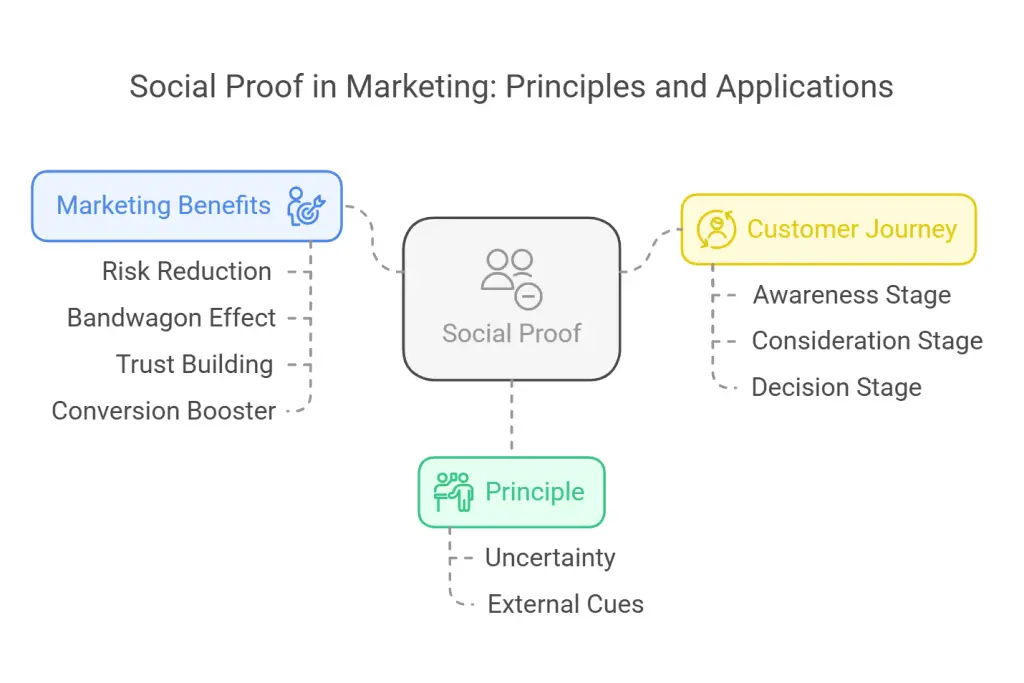
When Social Proof is Most Powerful
The effectiveness of social proof rises at key moments of the customer journey:
- Awareness Stage: Prospective customers often start with broad research. Social proof can serve as an attention-grabber and trust-builder.
- Consideration Stage: This is where users weigh different options. Detailed testimonials, case studies, and review snippets become essential.
- Decision Stage: At the point of purchase, the right piece of social proof—perhaps an endorsement from a relevant influencer—can tip the scales in your favor.
Pinpoint customer touchpoints where uncertainty might be high. Strategically place reviews, testimonials, or endorsements there. This proactive approach can eliminate doubts and accelerate conversions.
Types of Social Proof in Marketing
1. Customer Reviews & Ratings
Of all forms of social proof, customer reviews and ratings are often the most persuasive. They represent genuine experiences that reflect what a new buyer can likely expect. The numbers back this up: most consumers consult reviews before making purchases, whether buying household items or picking a vacation rental.
Example (Fictional Case Study):
“Alice’s Art Supplies” noticed that many shoppers added items to their cart but abandoned the checkout page. After launching an automated follow-up email asking for customer reviews, they displayed the resulting star ratings and short quotes directly on product pages. Within two months, Alice’s Art Supplies reported a 40% drop in cart abandonment and a 25% increase in average order value. Shoppers felt more confident when they read genuine feedback—particularly noting that certain brushes had helped beginners feel more professional.
How to Leverage It:
- Use email reminders or incentives to nudge satisfied customers to leave a review.
- Display short review snippets under key product features.
- Integrate reputable review platforms like Google Reviews, Yelp, or Trustpilot for third-party validation.
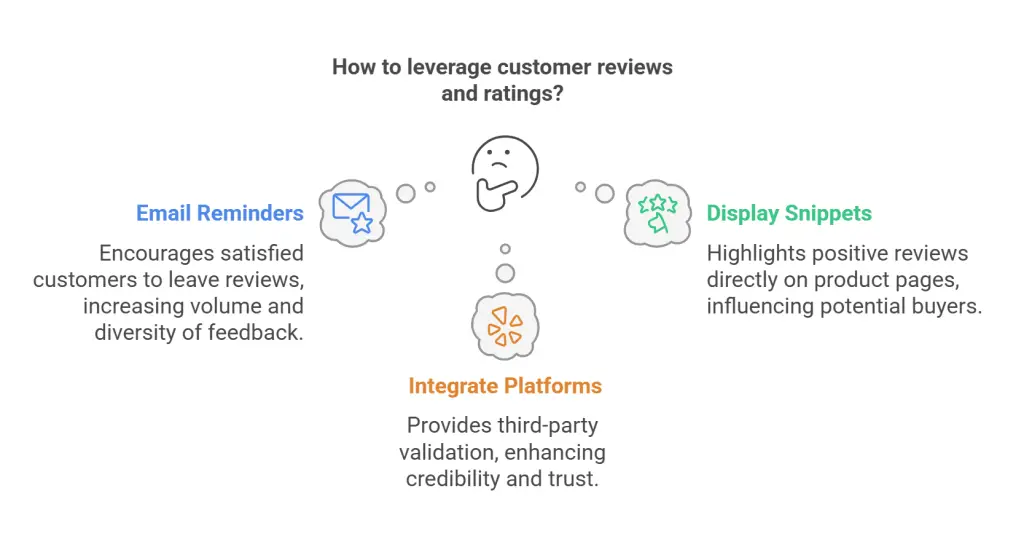
2. Testimonials & Case Studies
Testimonials often provide a narrative—explaining the initial problem the customer faced, how they discovered your product, and the results they achieved. Case studies take it a step further by adding data points and detailed context.
Example (Fictional Case Study):
“MaxFit Gym,” a boutique fitness center, documented the story of Tom, a busy professional who struggled with weight and stress. Through MaxFit Gym’s specialized training program, Tom lost 20 pounds and significantly reduced his stress levels in 12 weeks. The company shared Tom’s testimonial, complete with before-and-after photos and a short interview. New members soared by 45% after this case study launched on their website and social media platforms.
How to Leverage It:
- Collect detailed accounts from diverse customer segments, so prospective buyers see themselves reflected.
- Use video testimonials where possible. Hearing genuine enthusiasm in someone’s voice can be more impactful than plain text.
- Place testimonials prominently on high-impact pages, such as your homepage, product pages, or the final step of a checkout process.
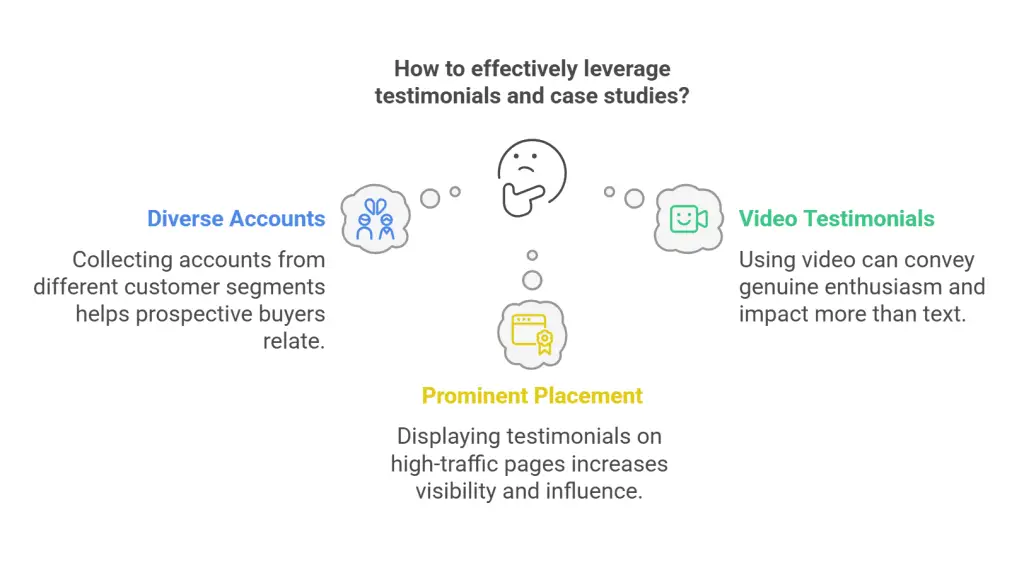
3. Influencer & Expert Endorsements
Influencers and experts—whether they’re well-known celebrities, niche micro-influencers, or industry specialists—can lend a sense of authority to your brand. Their followers or fans tend to trust their opinions.
Example (Fictional Case Study):
“TechVerse,” a start-up creating cutting-edge smart home devices, partnered with a mid-level tech YouTuber who had a loyal subscriber base of 300,000 people. After the influencer did an in-depth unboxing and honest review of TechVerse’s flagship product, site traffic spiked by 200% within 24 hours. Sales tripled in a single weekend, all driven by the trust that influencer had built with their audience over years of detailed product reviews.
How to Leverage It:
- Reach out to micro-influencers who fit your brand’s personality and audience.
- Provide influencers with early product samples or a unique experience so they can create genuine content.
- Consider co-branded campaigns or giveaways to amplify reach and engagement.
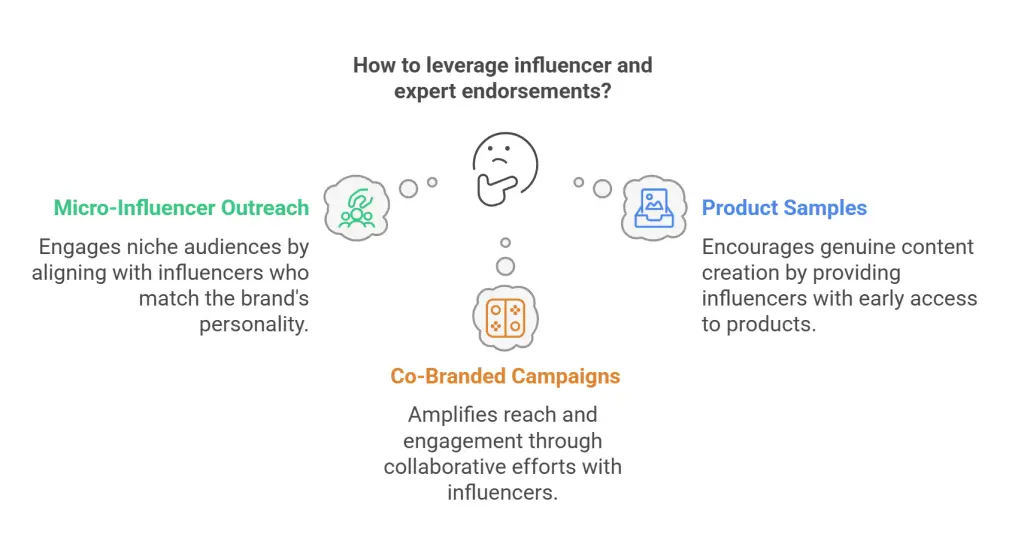
4. Crowd Statistics & User Counts
People tend to trust products and services that boast big numbers. Whether it’s “Over 1,000,000 copies sold” or “Join our 200,000 subscribers,” displaying these figures nudges people to follow the crowd.
Example (Fictional Case Study):
A subscription-based language app, “LingoReady,” placed a large banner on their homepage stating “Used by over 2 million people worldwide!” Within the first month of highlighting that statistic, LingoReady saw a 30% increase in new sign-ups. Seeing that a vast community was already benefiting from the app reassured prospective users.
How to Leverage It:
- Highlight any significant milestone—registered users, product downloads, or number of positive reviews.
- Include phrases like “Top-rated” or “Best seller” to reinforce your popularity.
- Update these numbers periodically to keep them accurate and to reflect growth.
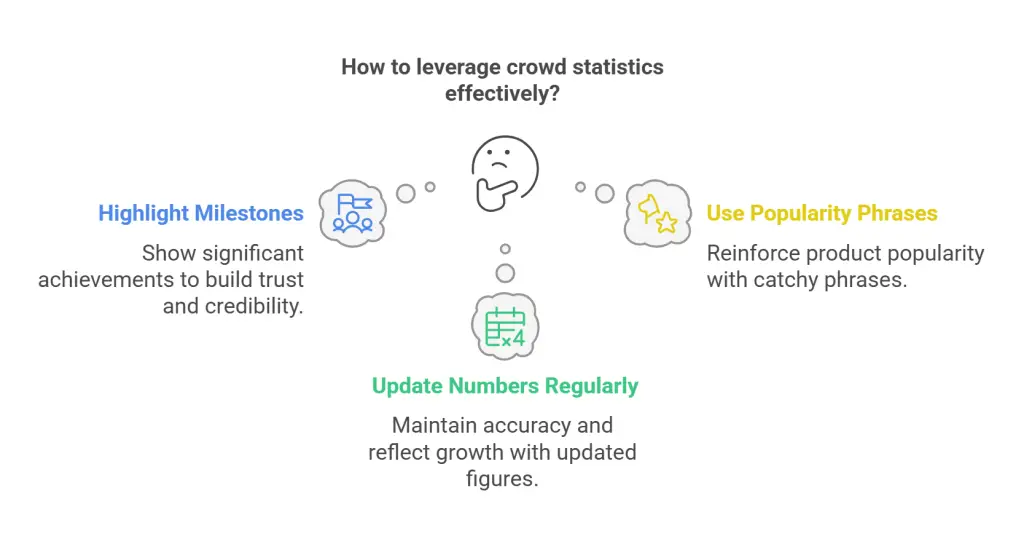
5. Social Media Proof
Likes, shares, and posts from real users operate as modern-day word-of-mouth marketing. They can be especially potent for brands targeting younger audiences who are active on social media platforms.
Example (Fictional Case Study):
“Glow & Shine Cosmetics” launched a #GlowWithConfidence challenge on Instagram, inviting customers to post short before-and-after reels using the brand’s signature highlighter palette. In just two weeks, they generated over 5,000 user-created videos. The brand reposted some of the most creative clips, and website traffic skyrocketed. The social proof from everyday users demonstrating real results fostered immediate trust with potential buyers.
How to Leverage It:
- Create branded hashtags and encourage customers to share photos or videos of them using your product.
- Repost user-generated content (UGC) on your official channels to show appreciation.
- Embed social feeds on your website to display ongoing interactions and community buzz.
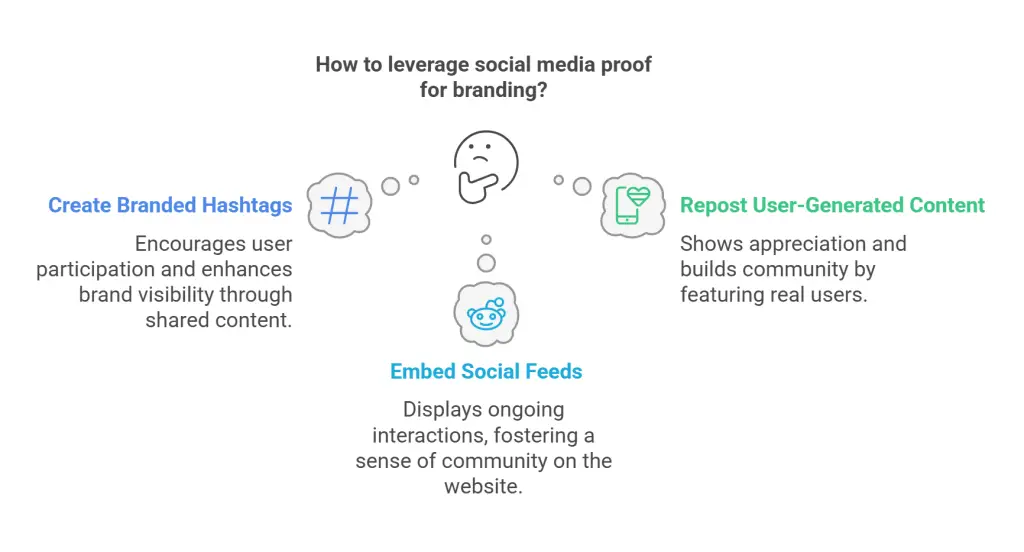
Psychological Foundations of Social Proof
1. The Fear of Missing Out (FOMO)
FOMO capitalizes on a basic human desire: we don’t want to be left out of something beneficial or popular. Coupled with social proof—like a notice that a product is “selling fast”—FOMO can spark swift decision-making.
Fictional Scenario:
A flash sale website advertises: “Only 3 items left in stock—45 people viewing this product right now.” Shoppers feel a sense of urgency. They see that many others are eyeing the same item, fear it will go out of stock, and quickly click “Buy Now.”
2. Normative vs. Informational Social Influence
- Normative Influence: People follow group norms to be liked or to fit in. If you see everyone raving about a new mobile app, you might feel compelled to try it too, lest you miss an inside joke or relevant conversation.
- Informational Influence: When unsure, people rely on those they perceive as more knowledgeable. Product reviews, testimonials from industry experts, and influencer endorsements act as signposts pointing to the “right choice.”
3. The Authority Principle
Authority figures—be they scientists, academics, or high-profile gurus—command respect. Their endorsements can overshadow self-promotional advertising because viewers inherently believe an authority is knowledgeable or discerning.
Key Takeaway:
Combine authority endorsements with crowd validation for maximum effect. For instance, if an esteemed dermatologist endorses a skincare product that also has hundreds of glowing reviews, the dual layers of credibility strengthen its social proof.
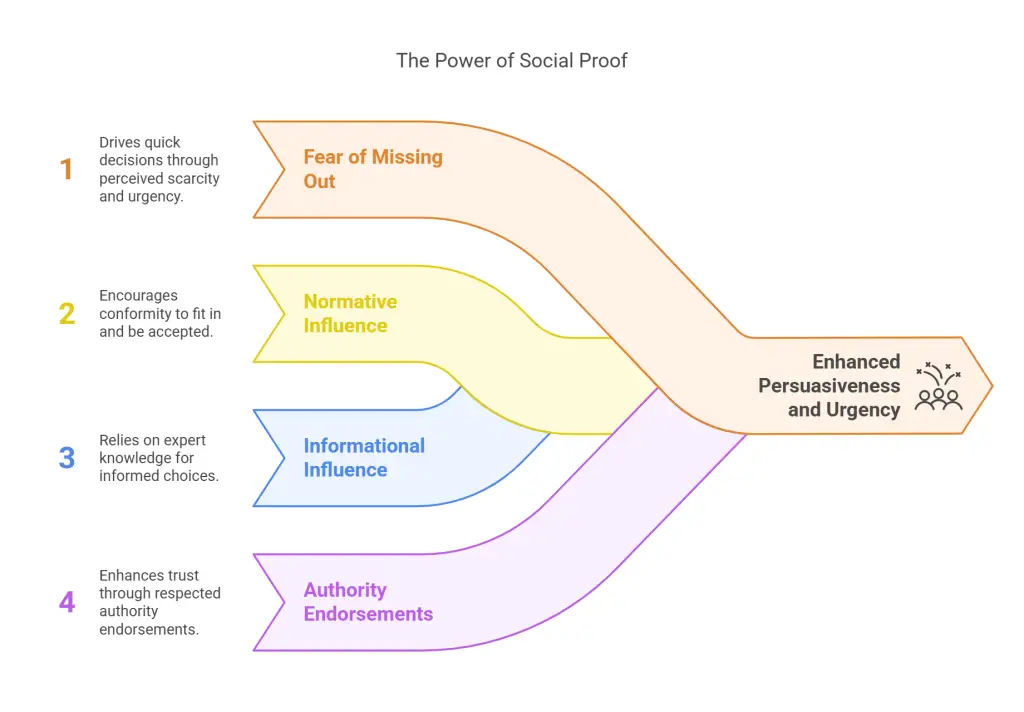
Strategies for Implementing Social Proof
1. Ask for Reviews Proactively
Many happy customers simply don’t think to leave a review. Politely prompting them via email or an in-app notification after a purchase can generate a steady stream of testimonials.
Practical Tips:
- Automate review requests a few days after delivery.
- Include direct links to review platforms.
- Offer loyalty points or small freebies as a thank-you for their time.
2. Showcase Testimonials Everywhere
Place user testimonials not only on your testimonial page but also on homepages, product listings, and blog posts. A short excerpt from a longer testimonial can be used as a compelling visual quote card to catch people’s attention.
3. Foster User-Generated Content
Encourage your community to share stories, photos, or videos. This can be done through contests, giveaways, or simple prompts like “Show us how you use our product!” Repost these user creations on your official channels to validate and celebrate your enthusiastic supporters.
4. Collaborate with Experts and Influencers
Identify figures who resonate with your target demographic and propose collaborations that feel natural. An authentic product endorsement from a respected figure in your niche can be a game-changer.
5. Leverage “Wisdom of the Crowd”
Experiment with phrases that highlight popularity, such as “Join 5,000 others who purchased today!” or “Our top-rated course with over 1,000 five-star ratings.” These callouts convey a sense that many people are benefiting from what you offer.

Examples of Social Proof in Action
1. Happy Pup Pet Supplies
Scenario:
Happy Pup Pet Supplies is a small online store selling specialized organic pet treats. They initially struggled to stand out among larger pet supply brands.
What They Did:
- Featured a live social media feed on their homepage with customers sharing photos of their pets enjoying the treats.
- Offered a “100% satisfaction guarantee,” and requested honest feedback via email, generating over 300 reviews in a month.
- Collaborated with a veterinarian who wrote a blog on why organic treats are beneficial for canine health.
Result:
Within three months, Happy Pup Pet Supplies saw a 60% increase in repeat purchases. Website engagement metrics also improved, with more visitors clicking on product pages and adding items to their carts.
2. SkillBoost Online Courses
Scenario:
SkillBoost, a platform offering specialized business training, faced a challenge in converting new visitors into enrolled students.
What They Did:
- Curated success stories from top-performing students, including interviews that outlined their journey from novice to expert.
- Displayed enrollment numbers prominently: “Join 20,000+ global learners.”
- Partnered with a well-known entrepreneur who provided expert modules in their advanced courses.
Result:
Course enrollments surged by 35% in six weeks. The combination of real-life success stories, a trusted authority figure, and visible enrollment data created compelling social proof.
Measuring the Impact of Social Proof
A common oversight is failing to measure how social proof influences conversions. Track relevant metrics to evaluate what’s effective and what isn’t:
- Conversion Rate: Compare conversion rates before and after implementing testimonials or reviews.
- Click-Through Rate (CTR): If you add a testimonial section to an email, monitor how many more people click on your call-to-action link.
- Engagement Rate: For social media campaigns, look at likes, comments, shares, or new followers gained during a social proof initiative.
- Average Order Value (AOV): Check if displaying reviews encourages customers to buy more or upgrade to higher-priced items.
Once you gather enough data, refine your approach. If a particular testimonial resonates more with your audience, highlight it more prominently. If an influencer campaign underperforms, test a different influencer or a different social platform.
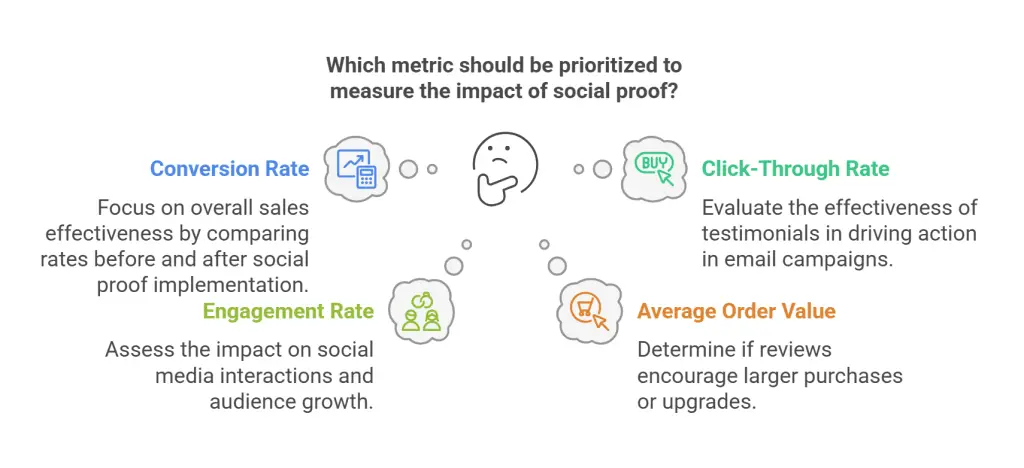
Common Pitfalls and Mistakes to Avoid
- Overusing or Fabricating Reviews
Oversaturation with suspiciously generic praise can raise red flags. Authenticity is the cornerstone of social proof. Also, fabricating or exaggerating reviews can damage trust irreparably if exposed. - Failing to Update Testimonials
A brand that still features a “2019 Customer of the Month” might look outdated. Regularly refreshing reviews, statistics, and endorsements keeps your content relevant and credible. - Neglecting Less-Than-Perfect Feedback
Hiding or deleting slightly negative reviews can backfire by making your review ecosystem seem fake. Surprisingly, a balanced review profile often boosts trust. Customers expect some varied opinions; an all-five-star record can appear suspicious. - Using Influencers Who Aren’t a Good Fit
A mismatch between influencer and product undermines credibility. Always ensure you partner with influencers who genuinely align with your brand values and target market. - Ignoring Cultural and Regional Differences
Social proof that resonates in one region might be irrelevant elsewhere. Localize your approach, especially for crowd statistics or user testimonials, to speak to the specific market you’re targeting.
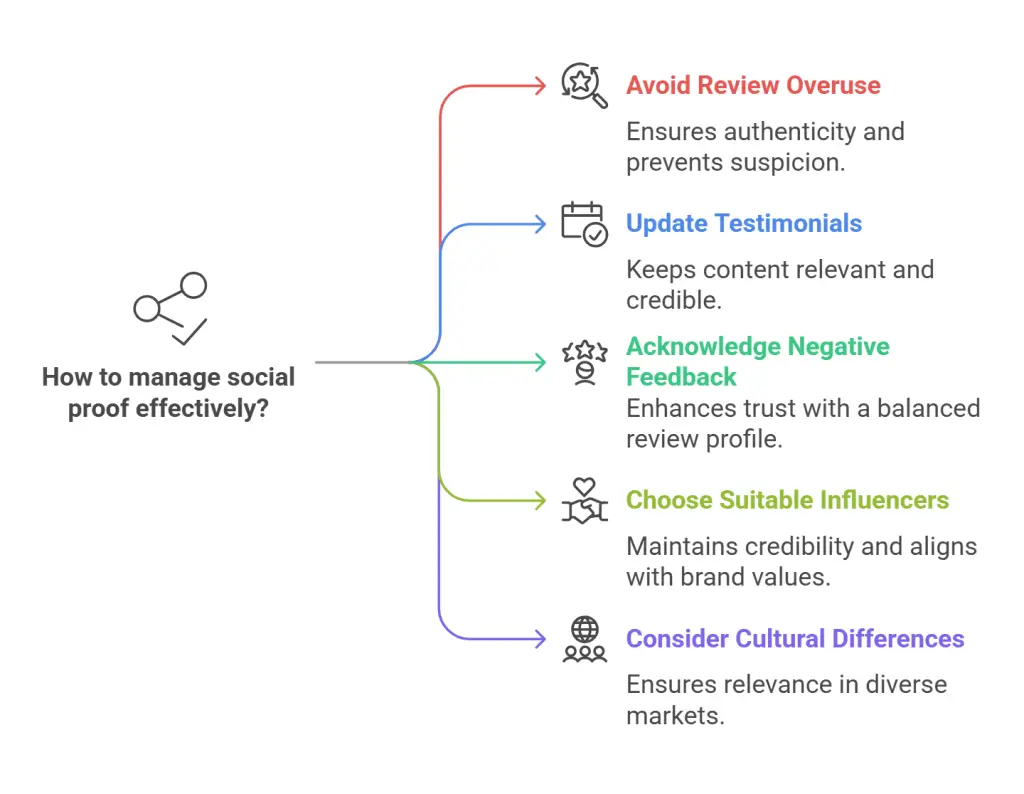
Case Study: Solara Eco-Friendly Clothing
To illustrate how all these elements might integrate, consider a fictional brand called Solara. They specialize in eco-friendly clothing. Their mission is to reduce fast-fashion waste and encourage a more sustainable lifestyle.

The Challenge
Solara launched online but struggled to compete with mainstream brands offering cheaper but less sustainable clothing. Although their garments were high-quality and environmentally friendly, they weren’t getting enough traffic or conversions.
Step 1: Encouraging Customer Reviews
Solara started by implementing a post-purchase email workflow. When a customer received their items, they got an email requesting a review. Within each email, Solara briefly explained the positive environmental impact of each purchase and asked for honest feedback. The brand also offered a small discount on a future order as an incentive.
Within a month, they accumulated over 500 reviews. Some reviews were short, but many were detailed, praising the comfortable fit, stylish design, and eco-friendly materials. Solara prominently displayed average star ratings and excerpts on product pages.
Step 2: Crafting Case Studies and Testimonials
Next, they identified three customers who had compelling stories—like a college student who only bought thrifted clothes until discovering Solara, or a professional who’d spent years looking for stylish yet ethically made work attire. They documented each person’s challenges, the solutions Solara provided, and any quantifiable benefits (e.g., fewer items purchased overall, clothes lasting longer).
They compiled these into brief testimonials and dedicated case study pages. Each page included photos of the real customers wearing Solara apparel, plus quotes about how the brand changed their shopping habits. These personal narratives showcased how sustainable fashion can be both practical and stylish.
Step 3: Partnering with Influencers and Experts
Solara reached out to eco-conscious influencers on Instagram and YouTube, specifically those known for promoting zero-waste or minimalist lifestyles. They offered these influencers free clothing samples, tours of the brand’s production facilities (virtually, through videos), and transparent data on their supply chain.
Within weeks, numerous influencers posted videos and stories explaining Solara’s fabric sourcing methods and worker welfare policies. They highlighted how wearing Solara contributed to lowering their environmental footprint. Each influencer provided a unique discount code, which Solara tracked to measure conversions.
Step 4: Displaying Crowd Statistics
On Solara’s homepage, a new banner appeared: “Over 5,000 happy customers and counting.” They also added a real-time purchase pop-up that occasionally announced recent purchases with the buyer’s location (e.g., “Jennifer from Portland just bought our organic cotton hoodie!”). This subtle notification indicated that people all over the country were placing orders.
Step 5: Encouraging User-Generated Content
Solara launched the #SolaraStyle hashtag challenge, inviting customers to post Instagram or TikTok videos showing how they style their eco-friendly outfits for different occasions. The brand reposted the most creative submissions, sending each featured user a personalized thank-you note and a small gift.
As the hashtag gained traction, Solara’s social media channels lit up with real customers proudly promoting sustainable fashion. This organic brand advocacy reinforced Solara’s position as a community-driven, ethical brand.
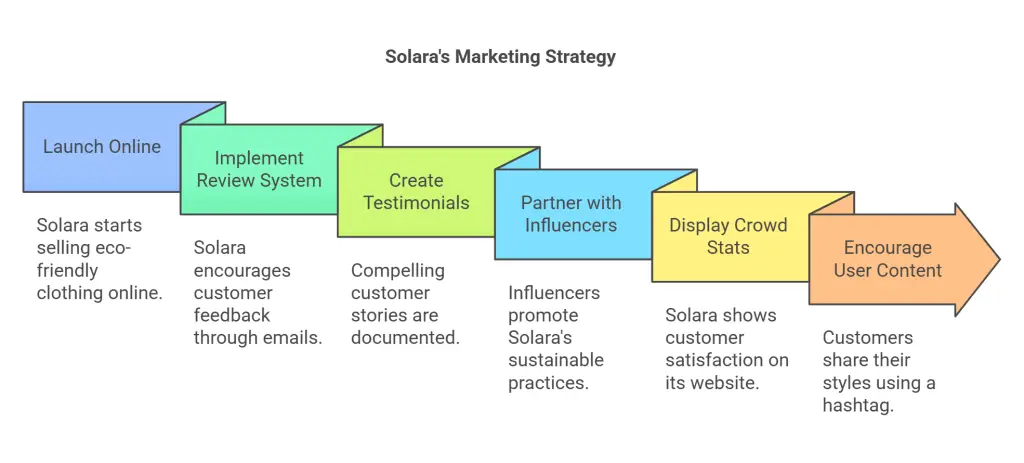
The Results
Within three months:
- Conversion Rate jumped by 50%.
- Social Media Engagement doubled, with the #SolaraStyle hashtag trending for several days in the sustainable fashion niche.
- Influencer Campaign codes led to a substantial lift in first-time buyers.
- Average Order Value (AOV) climbed by 20%, as satisfied customers often added multiple items to their carts.
The combination of all forms of social proof—reviews, testimonials, influencer endorsements, crowd statistics, and user-generated content—transformed Solara from a little-known start-up to a recognized name in the eco-friendly fashion space.
Conclusion
Social proof has the power to bridge the trust gap between what you say as a business and what customers actually believe. Whether it’s showing ratings and reviews, leveraging influential voices, or demonstrating the sheer size of your user base, social proof reassures potential buyers that the value you promise is real.
Here’s a concise path to begin:
- Identify Key Customer Doubts: Figure out where potential customers hesitate the most—maybe on product pages or during checkout.
- Select the Right Social Proof Tactic: Whether it’s a powerful testimonial, a user-generated content campaign, or an influencer review, pick what aligns best with your brand and audience.
- Implement & Measure: Add these trust signals to your marketing channels, then track metrics like conversions, engagement, and average order value.
- Refine & Scale: As you see results, keep iterating. Add new testimonials, explore different influencer partnerships, and encourage more user-generated content.
Pick one type of social proof to experiment with this week—maybe a simple prompt for reviews or a small social media contest. After you see how it boosts engagement and conversions, scale your approach. Social proof, when used authentically, becomes a reliable pillar of your marketing. So go ahead and share your success stories, display your five-star ratings, and let real customers do the talking.
Frequently Asked Questions
What is social proof in marketing?
Social proof is the psychological phenomenon where individuals look to others’ actions and opinions to guide their own decisions. In marketing, it involves using testimonials, reviews, and endorsements to influence potential customers’ trust and purchasing behavior.
Why is social proof important for small businesses?
Social proof builds credibility and trust, essential for small businesses. Positive reviews and testimonials can reassure potential customers, reduce perceived risk, and increase conversion rates, leading to business growth.
How do testimonials and reviews serve as social proof?
Testimonials and reviews provide unbiased, user-generated content that showcases real experiences with a product or service. They act as endorsements, influencing potential customers’ perceptions and decisions by highlighting satisfaction and value.
What are some effective types of social proof?
Effective types include customer testimonials, online reviews, expert endorsements, social media mentions, user-generated content, and displaying the number of users or subscribers. Each leverages others’ approval to build trust with potential customers.
How can small businesses leverage social proof in their marketing strategies?
Small businesses can showcase customer testimonials on their websites, encourage satisfied customers to leave positive reviews, collaborate with industry experts for endorsements, and share user-generated content on social media to build credibility and attract new customers.
Further reading
Web Articles
- Forbes Business Development Council. “How Reviews and Ratings Affect Clients’ Buying Decisions.” Forbes, July 11, 2024. https://www.forbes.com/councils/forbesbusinessdevelopmentcouncil/2024/07/11/how-reviews-and-ratings-affect-clients-buying-decisions/. Accessed March 3, 2025.
- Dixa. “3 Important Statistics That Show How Reviews Influence Consumers.” Dixa Blog. https://www.dixa.com/blog/3-important-statistics-that-show-how-reviews-influence-consumers/. Accessed March 3, 2025.
- Australian Competition & Consumer Commission. Online Reviews and Testimonials: A Guide for Business and Review Platforms. Australian Government, 2021. https://www.accc.gov.au/system/files/online-review-and-testimonials.pdf. Accessed March 3, 2025.
- Debutify. “Reviews and Testimonials: Best Practices.” Debutify Blog. https://debutify.com/blog/reviews-and-testimonials-best-practices. Accessed March 3, 2025.
- Resaco. “The Impact of Customer Reviews and Testimonials on B2C Lead Generation.” Resaco Blog. https://resaco.fi/en/the-impact-of-customer-reviews-and-testimonials-on-b2c-lead-generation/. Accessed March 3, 2025.
- Frontiers in Psychology. “Online Reviews and Consumer Decision-Making: A Psychological Perspective.” Frontiers in Psychology 13 (2022). https://www.frontiersin.org/journals/psychology/articles/10.3389/fpsyg.2022.865702/full. Accessed March 3, 2025.
- Quora. “How Often Do You Make Purchase Decisions Based on Online Reviews and Testimonials?” Quora Discussion Forum. https://www.quora.com/How-often-do-you-make-purchase-decisions-based-on-online-reviews-and-testimonials. Accessed March 3, 2025.
YouTube Videos
BrightLocal. “How to Get More Online Reviews (and Make Them Work for You).” YouTube video, 10:12. March 2023. https://www.youtube.com/watch?v=GCW9JMaLZT4. Accessed March 3, 2025.
Google Small Business. “How Online Reviews Shape Consumer Behavior.” YouTube video, 3:27. July 2023. https://www.youtube.com/watch?v=YeybJL4Ll8U. Accessed March 3, 2025.
Neil Patel. “Why Customer Reviews Matter for Your Business.” YouTube video, 7:45. October 2022. https://www.youtube.com/watch?v=2sfvwREJRgg. Accessed March 3, 2025.







